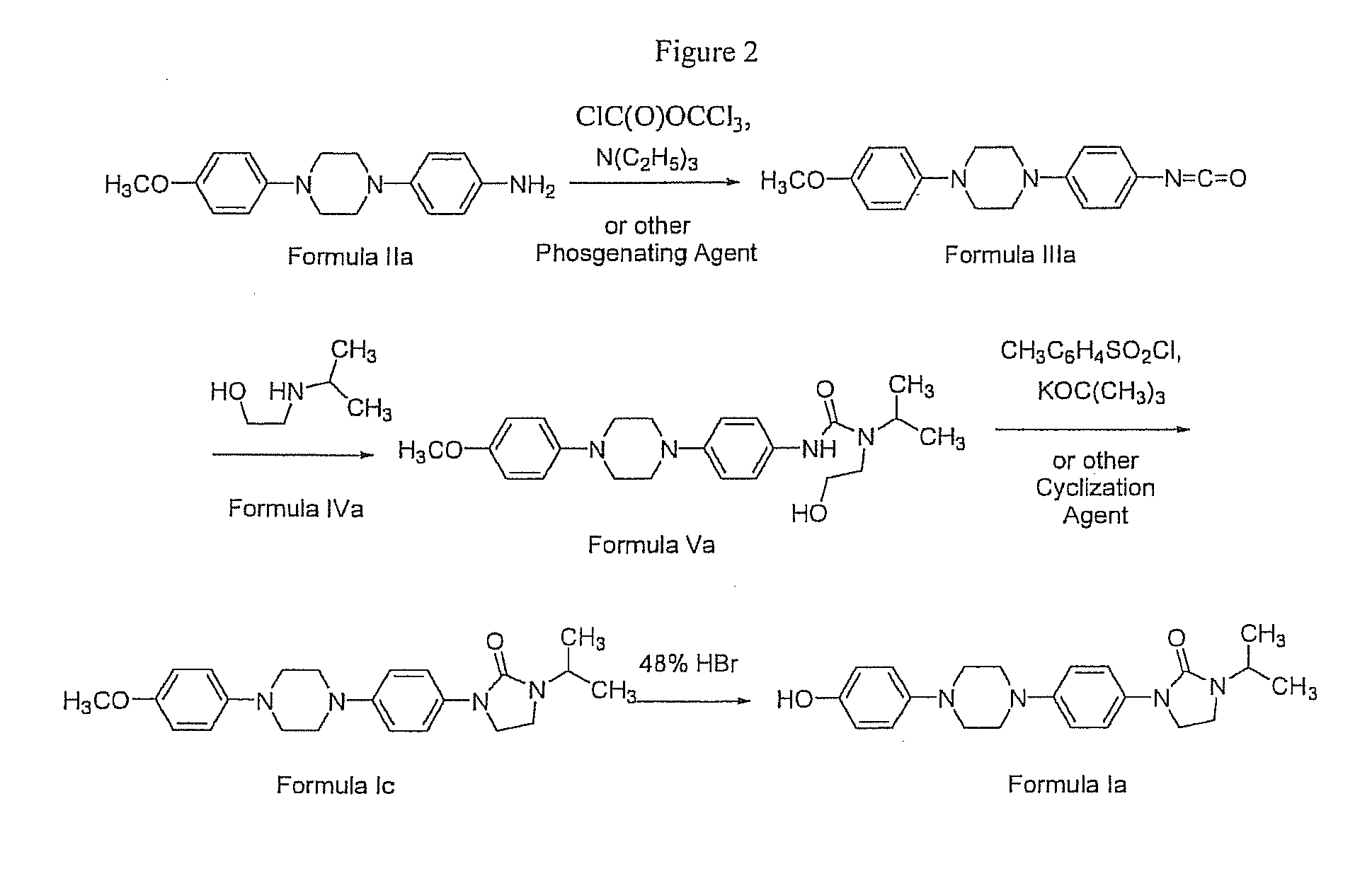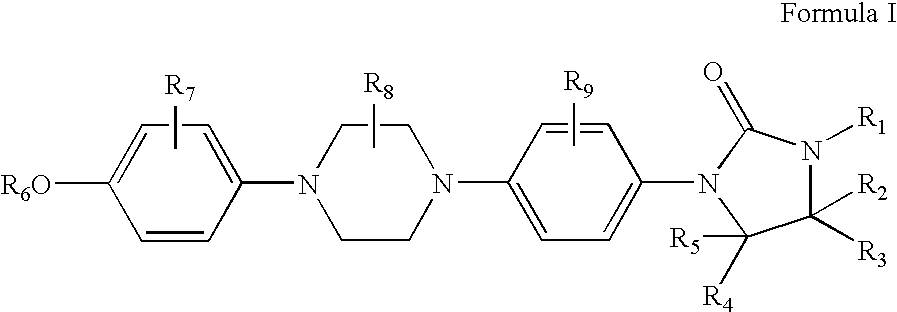Method for manufacture of 2-oxoimidazolidines
a technology of oxoimidazolidine and 2-oxoimidazolidine, which is applied in the direction of organic chemistry, etc., can solve the problems of difficult removal process, low overall product yield, and inconvenient operation, and achieve the effect of large-scale manufacturing and convenient operation
- Summary
- Abstract
- Description
- Claims
- Application Information
AI Technical Summary
Benefits of technology
Problems solved by technology
Method used
Image
Examples
example 1
Procedure for Preparation of 4-[4-(4-Methoxyphenyl)-1-piperazinyl]phenylisocyanate (Formula IIIa)
[0077]To a dichloromethane (400 mL) solution of diphosgene (74 mmol, 14.8 g) at 0° C. was added a dichloromethane (1100 mL) solution of 4-[4-(4-methoxyphenyl)-1-piperazinyl]benzenamine (Formula IIa, 41 mmol, 11.7 g) and triethylamine (93 mmol, 9.4 g) over a period of 3.5 hours. Once the addition was complete, the reaction was stirred in an ice bath for an additional 30 minutes. The reaction solvent was evaporated, the residue dissolved in tetrahydrofuran (300 mL), and the insolubles removed by filtration. The filtrate was concentrated by rotary evaporation to give 4-[4-(4-methoxyphenyl)-1-piperazinyl]-phenylisocyanate as a beige solid (12.8 g, 100% crude yield). The product was advanced to the next reaction step without purification. 1H NMR (400 MHz, CDCl3) δ 7.08-6.85 (m, -Ar), 3.79 (s, 3 H, OCH3), 3.45-3.20 (m, 8 H, CH2).
example 2
Procedure for Preparation of N-[4-[4-(4-Methoxyphenyl)-1-piperazinyl]-phenyl]-N′-2-methylethyl-N′-[2-hydroxyethyl]urea (Formula Va)
[0078]To a dichloromethane (230 mL) solution of 2-(2-methylethylamino)ethanol (Formula IVa, 210 mmol, 30.9 g) at ambient temperature was added 4-[4-(4-methoxyphenyl)-1-piperazinyl]-phenylisocyanate (Formula IIIa, 35 mmol, 10.9 g) as a solid over a period of 40 minutes. During the course of the addition, the solution turned from red to dark red. Upon completion of the addition, the reaction was stirred for 2 hours at which time the solution was an opaque brown. The reaction solvent was evaporated and the residue triturated for 30 minutes in a mixture of dioxane (140 mL) and water (60 mL). The product was filtered and dried to give N-[4-[4-(4-methoxyphenyl)-1-piperazinyl]-phenyl]-N′-2-methylethyl-N′-[2-hydroxyethyl]carbamate as a slightly-damp, light brown powder (15.2 g, 100% crude yield). The product was used directly in the next step without further pur...
example 3
Procedure for Preparation of 1-[4-[4-(4-Methoxyphenyl)-1-piperazinyl]phenyl]-3-(1-methylethyl)-2-oxoimidazolidine (Formula Ic)
[0079]To a slurry of N-[4-[4-(4-methoxyphenyl)-1-piperazinyl]-phenyl]-N′-2-methylethyl-N′-[2-hydroxyethyl]urea (Formula Va, 35.0 mmol, 14.4 g) in tetrahydrofuran (600 mL) was added potassium tert-butoxide (123.0 mmol, 11.2 g). The reaction vessel was cooled in an ice bath and a tetrahydrofuran (200 mL) solution of p-toluenesulfonyl chloride (57.0 mmol, 10.9 g) was added over a period of 0.5 hours. The resulting beige mixture was allowed to stir at ambient temperature for 14 hours before addition of water (200 mL). The mixture was filtered and the product was washed with water (200 mL) and dried. A white powder of 1-[4-[4-(4-methoxyphenyl)-1-piperazinyl]phenyl]-3-(1-methylethyl)-2-oxoimidazolidine (10.6 g) was obtained in 77% overall yield from 4-[4-(4-methoxyphenyl)-1-piperazinyl]benzenamine. 1H NMR (400 MHz, CDCl3) δ 7.46 (d, J=9.2 Hz, 2 H, Ar), 6.96 (d, J=9...
PUM
| Property | Measurement | Unit |
|---|---|---|
| temperature | aaaaa | aaaaa |
| temperature | aaaaa | aaaaa |
| temperature | aaaaa | aaaaa |
Abstract
Description
Claims
Application Information
 Login to View More
Login to View More - R&D
- Intellectual Property
- Life Sciences
- Materials
- Tech Scout
- Unparalleled Data Quality
- Higher Quality Content
- 60% Fewer Hallucinations
Browse by: Latest US Patents, China's latest patents, Technical Efficacy Thesaurus, Application Domain, Technology Topic, Popular Technical Reports.
© 2025 PatSnap. All rights reserved.Legal|Privacy policy|Modern Slavery Act Transparency Statement|Sitemap|About US| Contact US: help@patsnap.com



